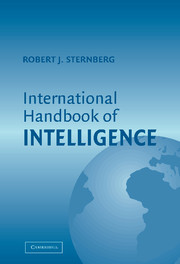Book contents
- Frontmatter
- Contents
- List of Contributors
- Preface
- 1 Intelligence Research and Assessment in the United Kingdom
- 2 Intelligence – Theory, Research, and Testing in the Nordic Countries
- 3 The Psychology of Human Intelligence in Spain
- 4 Psychology of Human Intelligence in France and French-Speaking Switzerland
- 5 Research on Intelligence in German-Speaking Countries
- 6 Is It Possible to Study Intelligence Without Using the Concept of Intelligence? An Example from Soviet/Russian Psychology
- 7 Intelligence Theory, Assessment, and Research: The Israeli Experience
- 8 Intelligence and Intelligence Testing in Turkey
- 9 Intelligence: What Is Indigenous to India and What Is Shared?
- 10 Japanese Conception of and Research on Human Intelligence
- 11 Diligence Makes People Smart: Chinese Perspectives of Intelligence
- 12 Similar Thoughts under Different Stars: Conceptions of Intelligence in Australia
- 13 Being Intelligent with Zimbabweans: A Historical and Contemporary View
- 14 Intelligence Research in Latin America
- 15 North American Approaches to Intelligence
- 16 Human Intelligence: From Local Models to Universal Theory
- Index
- References
11 - Diligence Makes People Smart: Chinese Perspectives of Intelligence
Published online by Cambridge University Press: 05 June 2012
- Frontmatter
- Contents
- List of Contributors
- Preface
- 1 Intelligence Research and Assessment in the United Kingdom
- 2 Intelligence – Theory, Research, and Testing in the Nordic Countries
- 3 The Psychology of Human Intelligence in Spain
- 4 Psychology of Human Intelligence in France and French-Speaking Switzerland
- 5 Research on Intelligence in German-Speaking Countries
- 6 Is It Possible to Study Intelligence Without Using the Concept of Intelligence? An Example from Soviet/Russian Psychology
- 7 Intelligence Theory, Assessment, and Research: The Israeli Experience
- 8 Intelligence and Intelligence Testing in Turkey
- 9 Intelligence: What Is Indigenous to India and What Is Shared?
- 10 Japanese Conception of and Research on Human Intelligence
- 11 Diligence Makes People Smart: Chinese Perspectives of Intelligence
- 12 Similar Thoughts under Different Stars: Conceptions of Intelligence in Australia
- 13 Being Intelligent with Zimbabweans: A Historical and Contemporary View
- 14 Intelligence Research in Latin America
- 15 North American Approaches to Intelligence
- 16 Human Intelligence: From Local Models to Universal Theory
- Index
- References
Summary
INTRODUCTION
In an impressive comparative study on mathematics achievements of primary school students between the United States and China, Professor Harold Stevenson of the University of Michigan and his colleagues from the Institute of Psychology, Chinese Academy of Sciences, obtained some interesting findings (Stevenson & Stigler, 1992). One of them is that the mathematics test scores of Chinese students were much higher than the scores of American students, however, the mean level of satisfaction of Chinese parents was much lower than that of American parents. In this case, are American parents overly optimistic? Or are Chinese parents too insatiate? Is this because of the differences of cultures or because of the differences of education systems? We all know that the education system in China is quite different from the education system in the United States or in other Western countries. But when we consider the following example, the educational system seems not to be the reason, at least not the main reason.
I visited a mathematically talented class when I was at the University of Michigan in 2001. There were about 20 students in this special class. But 17 of them were Chinese (from Hong Kong, Taiwan, and mainland China). In this case, all the students are in the same classroom with the same teacher, and, of course, with the same educational system. But what does it mean that the most mathematically talented students are Chinese? Does it mean that Chinese students are naturally good at mathematics?
- Type
- Chapter
- Information
- International Handbook of Intelligence , pp. 325 - 343Publisher: Cambridge University PressPrint publication year: 2004
References
- 6
- Cited by



